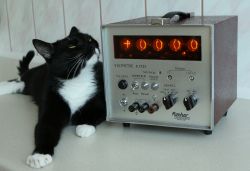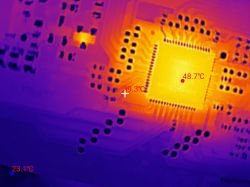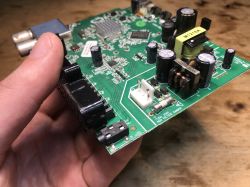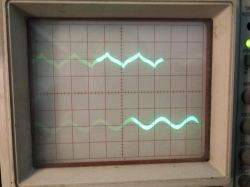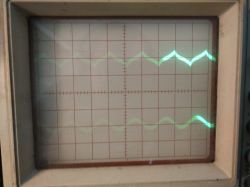I've been mulling over the idea of converting my wired Philips headphones, into Bluetooth headphones, with the option of a cable. I also want to convert my Dad's headphones (can't remember the manufacturer, but they play very decently). Admittedly, I already have one Bluetooth headphone, but "over-the-ear" (in the sense of an open design), and they would still be useful with a full shell.
I ordered a couple of different Bluetooth units because they were cheap, and listening remotely isn't possible.
I checked out maybe seven or eight of them, but they were either too big, or required a processor to work (which would make it much harder to stuff the whole thing into the headphone shells), or didn't have a charger on board, (which again forces you to stuff yet another board into the headphones). There were also those that seemingly met the requirements, but the sound quality was unacceptable.
I finally came across the chip, which will be the guest of today's article.
Below, as usual, is a photo from the auction:
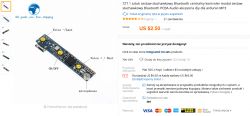 .
.
As you can see, as of today it comes out to less than ten Polish zloty. I paid 8,85PLN and I think it was money very well spent.
To start with, a few photos and then we'll get into the description of the circuit.
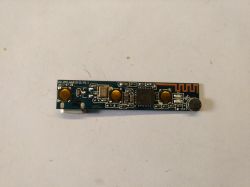
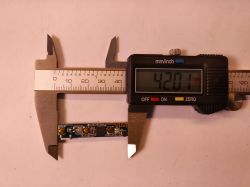
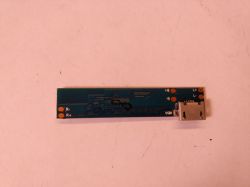 .
.
As you can see, the PCB is very small and can really do a lot.
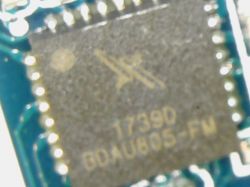
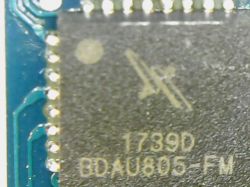
For the curious, a photo of the main (and only) integrated circuit. Taken with a microscope presented by me quite recently, on our forum.
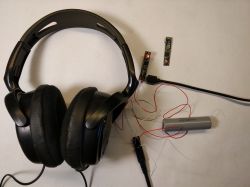
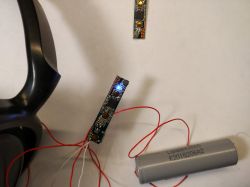
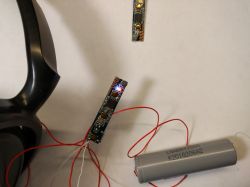 .
.
The diodes work as they do on probably all headphones. These are:
Pairing - the red and blue LED flashes alternately. Approximately every 0.5s
Connection - blue LED flashes, approximately every 2s.
Charging - red LED on.
End of charging - red LED off.
Switching off - the red LED lights up for approx. 2s. and we hear a message in the headphones indicating that the power has been switched off.
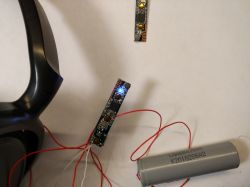
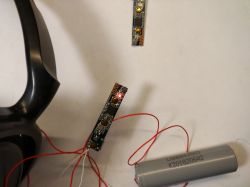
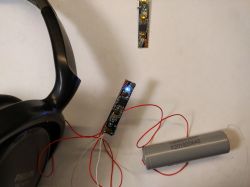 .
.
As with other Bluetooth headphones I have experienced, playback is not possible while charging.
So let's move on to the description that majfriend offers:
Bluetooth on Base CLASS 2 power level, using Bluetooth 2.1 + EDR specification, compatible with Bluetooth 3 and below application version, transmission speed can reach 3 Mbit .
I would like to add that the receiver/transmitter supports the A2DP standard. This means that we can listen to music from one source while connected to another. For example, you listen to music from your computer and are simultaneously connected to your phone. When a call comes in, you will hear the ringing tone in the headphones, and if you click the centre button to answer the incoming call, the music stops and you can hear the caller in the headphones. The module has a built-in microphone, so we will be able to start a conversation without any problems.
Power amplifier output power: RMS 2x18 mw (THD = 10%) .
I am left to believe that this is the case. Although, after the first test, I have no reason to doubt the veracity of this parameter.
The signal-to-noise ratio is not less than 90dB .
Here I don't know if there is an error or if the manufacturer/vendor has deliberately not given a specific value.
Input voltage: 3.7 v rechargeable lithium battery
That is, powering any Li-Ion, or Li-Fe, that is banging around in your drawer, while still fitting into one of the earphone shells.
Playback time: 5 hours: 7 hours .
Parameter given without making sense. The time depends on the power source used.
Charging time: 2-3 hours .
and here, as above...
Charges input voltage: DC5V 500 mah
I suspect that 250mA was meant.
Horn specification: 2x16 20 mw 10mm
I understand that you are referring to 2 x 20mW at 16Ω
Frequency response range: 20 hz-20 khz .
So the unwritten standard.
Sensitivity: = 100dB + 2dB .
I have nothing to measure.
SNR: 80Db transmitter/receiver frequencies: 2.4 --- 2.48 ghz
So standard.
Distance: unobstructed, 10 metres .
Works even when the phone is in a belt holster and wearing a solid rubber case.
The module only has three buttons, yet it is fully functional.
It works a little differently to my existing handsets and I'll probably confuse the reflex operation of one and the other, but I think I'll get used to it quickly.
It's time for some instruction on how to use this contraption, because despite only three buttons, we have quite a few options for their use.
The middle button, is responsible for:
- switching the receiver on/off - long press;
- Starting "pairing" - long press when the receiver is switched on;
- answering and ending an incoming call. If you hear a ringtone in your headphones (your own ringtone, the one set on your phone will not be played) and click this button, the call is answered and the music is muted. If we click it again during the call, the call is disconnected and the music reappears in the headphones.
2. the "Down" button
- a short click is responsible for switching to the next song playing;
- Hold down to decrease the volume in the headphones..
3. the "UP" button (viewed when the microphone is down and the board is upright):
- a short click is responsible for switching to the previously played song;
- holding down, will increase the volume in the headphones.
- holding down, will decrease the volume in the headphones.The above functions also work during a call.
All that's left for me now is to stuff the two modules into two pairs of headphones, but that's a topic for another article, in another section.
It's time to say a few words about the sound quality generated by this tiny chip.
When I plugged this invention in today, just for a test, on a mini kynar spider and put on the headphones "paired" with my phone, I got a shock. It plays as correctly as possible and quite pleasingly. The bass is deep and the treble is not lacking. I did a test and connected the same headphones directly to the 3.5mm jack socket on my phone. And here was another surprise...
The sound quality was worse than over Bluetooth. On top of that, it was also better than on my old Bluetooth headphones.
I was not surprised, however, that the headphones connected directly to the Yamaha RX-V596RDS aplituner, sounded "five classes higher", but in this case I was listening to a "real" amplifier and not a "junk" in an SMD casing.
To sum up.
I am very pleased to have finally come across a Bluetooth module that I can successfully use to convert my and my Dad's headphones.
It remains to select the right size batteries and deploy it all in the shells.
I can in good conscience recommend this module to anyone who wants to convert their old headphones into Bluetooth headphones with A2DP.
Best regards.
CMS
I ordered a couple of different Bluetooth units because they were cheap, and listening remotely isn't possible.
I checked out maybe seven or eight of them, but they were either too big, or required a processor to work (which would make it much harder to stuff the whole thing into the headphone shells), or didn't have a charger on board, (which again forces you to stuff yet another board into the headphones). There were also those that seemingly met the requirements, but the sound quality was unacceptable.
I finally came across the chip, which will be the guest of today's article.
Below, as usual, is a photo from the auction:
 .
.
As you can see, as of today it comes out to less than ten Polish zloty. I paid 8,85PLN and I think it was money very well spent.
To start with, a few photos and then we'll get into the description of the circuit.


 .
.
As you can see, the PCB is very small and can really do a lot.


For the curious, a photo of the main (and only) integrated circuit. Taken with a microscope presented by me quite recently, on our forum.


 .
.
The diodes work as they do on probably all headphones. These are:
Pairing - the red and blue LED flashes alternately. Approximately every 0.5s
Connection - blue LED flashes, approximately every 2s.
Charging - red LED on.
End of charging - red LED off.
Switching off - the red LED lights up for approx. 2s. and we hear a message in the headphones indicating that the power has been switched off.


 .
.
As with other Bluetooth headphones I have experienced, playback is not possible while charging.
So let's move on to the description that majfriend offers:
Bluetooth on Base CLASS 2 power level, using Bluetooth 2.1 + EDR specification, compatible with Bluetooth 3 and below application version, transmission speed can reach 3 Mbit .
I would like to add that the receiver/transmitter supports the A2DP standard. This means that we can listen to music from one source while connected to another. For example, you listen to music from your computer and are simultaneously connected to your phone. When a call comes in, you will hear the ringing tone in the headphones, and if you click the centre button to answer the incoming call, the music stops and you can hear the caller in the headphones. The module has a built-in microphone, so we will be able to start a conversation without any problems.
Power amplifier output power: RMS 2x18 mw (THD = 10%) .
I am left to believe that this is the case. Although, after the first test, I have no reason to doubt the veracity of this parameter.
The signal-to-noise ratio is not less than 90dB .
Here I don't know if there is an error or if the manufacturer/vendor has deliberately not given a specific value.
Input voltage: 3.7 v rechargeable lithium battery
That is, powering any Li-Ion, or Li-Fe, that is banging around in your drawer, while still fitting into one of the earphone shells.
Playback time: 5 hours: 7 hours .
Parameter given without making sense. The time depends on the power source used.
Charging time: 2-3 hours .
and here, as above...
Charges input voltage: DC5V 500 mah
I suspect that 250mA was meant.
Horn specification: 2x16 20 mw 10mm
I understand that you are referring to 2 x 20mW at 16Ω
Frequency response range: 20 hz-20 khz .
So the unwritten standard.
Sensitivity: = 100dB + 2dB .
I have nothing to measure.
SNR: 80Db transmitter/receiver frequencies: 2.4 --- 2.48 ghz
So standard.
Distance: unobstructed, 10 metres .
Works even when the phone is in a belt holster and wearing a solid rubber case.
The module only has three buttons, yet it is fully functional.
It works a little differently to my existing handsets and I'll probably confuse the reflex operation of one and the other, but I think I'll get used to it quickly.
It's time for some instruction on how to use this contraption, because despite only three buttons, we have quite a few options for their use.
The middle button, is responsible for:
- switching the receiver on/off - long press;
- Starting "pairing" - long press when the receiver is switched on;
- answering and ending an incoming call. If you hear a ringtone in your headphones (your own ringtone, the one set on your phone will not be played) and click this button, the call is answered and the music is muted. If we click it again during the call, the call is disconnected and the music reappears in the headphones.
2. the "Down" button
- a short click is responsible for switching to the next song playing;
- Hold down to decrease the volume in the headphones..
3. the "UP" button (viewed when the microphone is down and the board is upright):
- a short click is responsible for switching to the previously played song;
- holding down, will increase the volume in the headphones.
- holding down, will decrease the volume in the headphones.The above functions also work during a call.
All that's left for me now is to stuff the two modules into two pairs of headphones, but that's a topic for another article, in another section.
It's time to say a few words about the sound quality generated by this tiny chip.
When I plugged this invention in today, just for a test, on a mini kynar spider and put on the headphones "paired" with my phone, I got a shock. It plays as correctly as possible and quite pleasingly. The bass is deep and the treble is not lacking. I did a test and connected the same headphones directly to the 3.5mm jack socket on my phone. And here was another surprise...
The sound quality was worse than over Bluetooth. On top of that, it was also better than on my old Bluetooth headphones.
I was not surprised, however, that the headphones connected directly to the Yamaha RX-V596RDS aplituner, sounded "five classes higher", but in this case I was listening to a "real" amplifier and not a "junk" in an SMD casing.
To sum up.
I am very pleased to have finally come across a Bluetooth module that I can successfully use to convert my and my Dad's headphones.
It remains to select the right size batteries and deploy it all in the shells.
I can in good conscience recommend this module to anyone who wants to convert their old headphones into Bluetooth headphones with A2DP.
Best regards.
CMS
Cool? Ranking DIY



